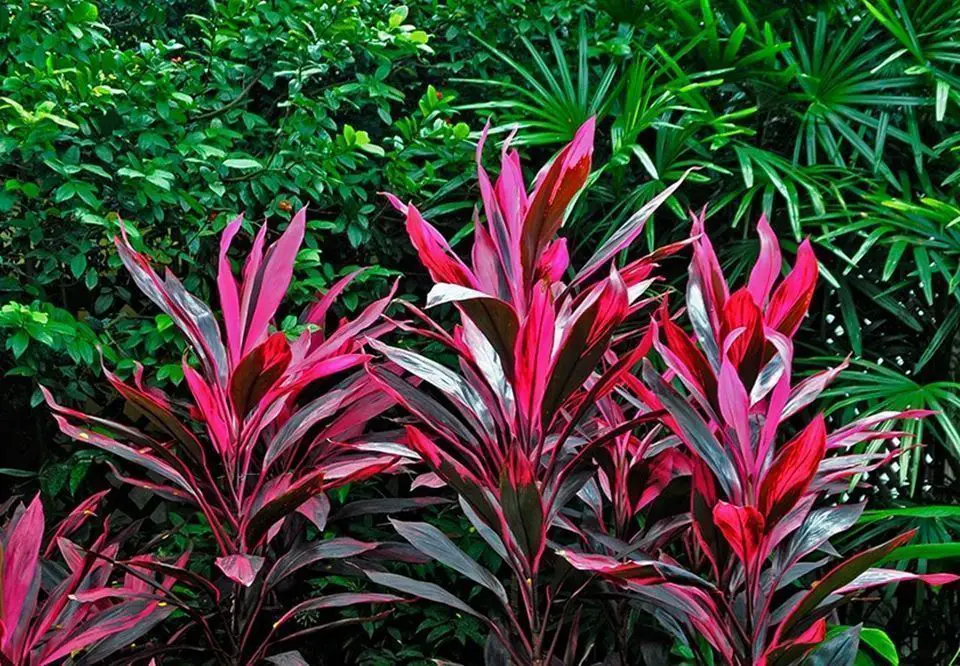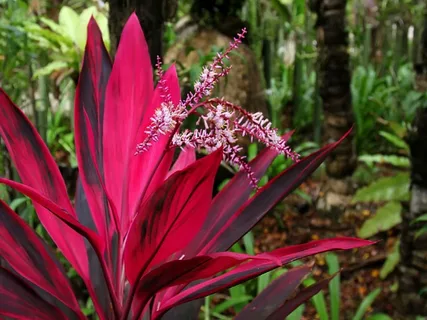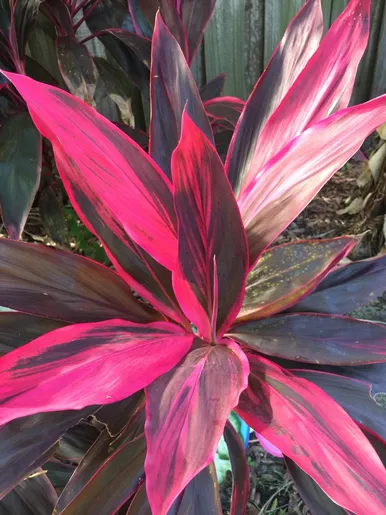Index
Introduction
The Pink Dracena, scientifically known as Cordyline fruticosa, is a fascinating ornamental plant that adds an exotic and vibrant touch to gardens and indoor environments. With its long, narrow leaves, often in shades of pink and red, this dracaena stands out for its unique beauty. Originally from the tropical regions of Asia and the Pacific, Cordyline fruticosa is appreciated not only for its stunning aesthetics, but also for its ease of cultivation.
Meaning of the Pink Dracena
In addition to its visual beauty, the Pink Dracena carries symbolic meanings. In many cultures, dracaenas are associated with prosperity, good luck and purifying the environment. The intense pink hue of the leaves adds an extra dimension, symbolizing warmth and affection. Growing this plant not only brings a tropical touch to the space, but also incorporates elements of positivity and well-being.
| Common Name | Pink Dracena |
|---|---|
| Botanical Name | Cordyline fruticosa |
| Family | Asparagaceae |
| Plant Type | Perennial |
| Adult Size | Up to 2 meters |
| Sun exposure | Indirect light in full sun |
| Soil type | Well-drained, rich in organic matter |
| soil pH | Slightly acidic to neutral |
| Flowering time | Spring to summer |
| Flower color | White to cream |
| Native Area | Asia and the Pacific |
| Toxicity | Non-toxic to humans and domestic animals |

How to care for Pink Dracena
The Pink Dracena is a stunning plant that requires specific care in order to thrive. Here are some guidelines to ensure that your Cordyline fruticosa blooms in all its splendor:
Light:
The Pink Dracena prefers indirect light to full sun. Place it in a spot where it receives filtered light for most of the day. Avoid direct exposure to intense sunlight for long periods, as this can cause damage to the leaves.
Soil:
Ensure a well-drained soil enriched with organic matter for the Pink Dracena. Make sure the container has drainage holes to avoid excessive water accumulation, which can lead to root problems.
Water:
Keep the soil evenly moist, but avoid waterlogging. Water when the top of the soil is dry to the touch. Pink Dracena is more tolerant of drought than excess water, so moderate your watering, especially during the colder months.
Temperature and humidity:
Cordyline fruticosa thrives in mild to warm temperatures. Avoid exposure to cold drafts. As for humidity, it appreciates more humid environments, but is adaptable to normal indoor conditions.
Fertilizing:
Fertilize Pink Dracena during spring and summer with a balanced fertilizer, diluted, every 4-6 weeks. Reduce applications during the fall and winter, when growth is slower. Follow the instructions on the fertilizer to avoid overdoing it.
By following these guidelines, you will provide an environment conducive to the healthy flowering of your Pink Dracena.

How to make Pink Dracena cuttings
Propagating Pink Dracena can be done relatively simply, allowing you to expand your collection. Follow the steps below to create new cuttings:
Step 1: Choosing the Material:
Choose to cut a healthy section of the Pink Dracena. Make sure that the cutting has at least a few knots, as it is from these points that new roots and leaves will develop.
Step 2: Preparing the Cut:
Use a sharp blade to make a clean cut at the base of the chosen segment. Remove excessive leaves at the bottom, leaving at least a few leaves at the top.
Step 3: Rooting in Water:
Place the cutting in a container of water, ensuring that the nodes are submerged. Change the water regularly to maintain purity and stimulate root growth.
Step 4: Transplant into soil:
When the roots reach a few centimeters in length, transfer the seedling to a pot with well-drained soil. Plant it so that the nodes and roots are covered.
How to plant Pink Dracena
When planting Pink Dracena, it is essential to create the ideal conditions for the plant’s healthy development. Here are the important steps:
Soil Preparation:
Make sure the soil is light, well-drained and enriched with organic matter. Pink Dracena prefers slightly acidic to neutral soils.
Site selection:
Position the plant in a spot with indirect light in full sun. Avoid direct exposure to strong sunlight for long periods, especially in hot climates.
Planting:
Dig a hole in the ground that is slightly larger than the plant’s root ball. Place the Pink Dracena in the hole and fill with soil, pressing gently around the base.
Initial watering:
After planting, water well to establish the plant. Keep the soil evenly moist for the first few days and adjust watering as necessary.
By following these guidelines, you’ll be well on your way to successfully propagating and planting your Pink Dracena.

Most common pests and diseases
When growing Pink Dracena, it is essential to be aware of the pests and diseases that can affect its health. Here is a list of the most common ones:
- Mites: Small insects that suck the sap, causing yellowish spots on the leaves.
- Mealybugs: Small, waxy-looking insects that attach themselves to leaves, extracting nutrients.
- Aphids: Small insects that feed on the sap, causing leaf deformities.
- Powdery mildew: A fungus that manifests itself as a layer of white powder on the leaves.
Common Problems and Their Solutions:
Yellowing leaves:
Cause: Overwatering or lack of nutrients. Solution: Adjust watering, check the soil and provide a balanced fertilizer.
Brown spots on the leaves:
Cause: Direct exposure to strong sunlight. Solution: Move the plant to a location with indirect light and protection from the intense sun.
Withered or drooping leaves:
Cause: Lack of water or very compacted soil. Solution: Water properly and ensure well-drained soil.
Pests:
Cause: Unsuitable growing conditions. Solution: Treat pests with mild insecticides or neem oil. Keep the plant healthy to avoid infestations.
By proactively monitoring and addressing these problems, you will ensure a vibrant Pink Dracena that is resistant to pests and diseases.
Curiosities and myths
Discover fascinating facts and unravel some myths related to Pink Dracena, a plant shrouded in mystery and beauty.
Curiosities:
1. Exotic origin:
The Pink Dracena, native to the tropical regions of Asia and Oceania, brings with it an exotic heritage, adding a special touch to any environment.
2. Purifying Air:
In addition to its charming aesthetics, the Pink Dracena is recognized for its air-purifying properties, helping to remove pollutants and promote a healthier environment.
3. Variety of Shapes:
With leaves ranging from shades of green to pink, this plant displays impressive diversity, offering options for all gardening tastes.

Myths:
1. Exaggerated Toxicity:
Despite some concerns, Pink Dracena is considered to be of low toxicity to humans and pets. However, it is always prudent to keep plants out of the reach of children and animals.
2. Complex Maintenance:
Contrary to the belief that it is difficult to care for, the Pink Dracena is a relatively hardy plant, adapting well to indoor environments with moderate lighting.
3. Unbridled Growth:
Contrary to the myth of rapid and uncontrollable growth, the Pink Dracena has moderate growth, allowing caretakers to maintain its size with regular pruning.
By exploring these curiosities and debunking some myths, you will have a more comprehensive and appreciative understanding of the Pink Dracena in your garden or indoor space.
Conclusion
Amid its exuberant beauty and unique qualities, the Pink Dracena stands out as an enchanting choice for plant enthusiasts. During our journey through this fascinating plant, we explored everything from its tropical origins to its air-purifying capacity, revealing the versatility that makes it a botanical treasure. In addition, we dispel common myths, clarifying that, with the right care, the Pink Dracena is an affordable and rewarding growing companion.
By considering aspects such as lighting, watering and possible pests, it is possible to provide an ideal environment for this captivating plant to flourish. With a color palette ranging from green to pink, the Pink Dracena offers not only a decorative touch, but also an invitation to explore the magic of plants in their most graceful form. Adopting Pink Dracena in your space is a commitment to aesthetics, health and harmony, providing a more vibrant and balanced home.
Frequently Asked Questions
Which dracaena can stay in the sun?
Dracena Marginata is a variety that tolerates sun exposure well. It thrives in places with indirect light to full sun, making it a versatile choice for well-lit indoor environments or for outdoor areas where it receives direct sunlight, as long as it is protected from the most intense hours.
How to care for pink dracena?
To care for the Pink Dracena , it is essential to provide bright indirect light, water moderately, keeping the soil slightly damp, and avoid cold drafts. Occasional pruning helps to maintain its desired shape. Adding fertilizer during the growing season contributes to healthy development. Watching for signs of stress, such as wilted leaves, helps to adapt the care to the plant’s needs.







